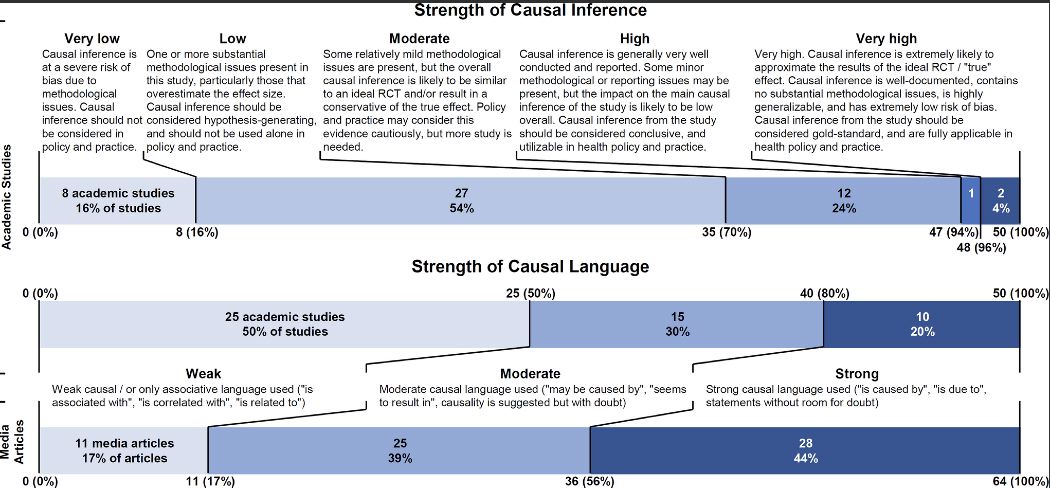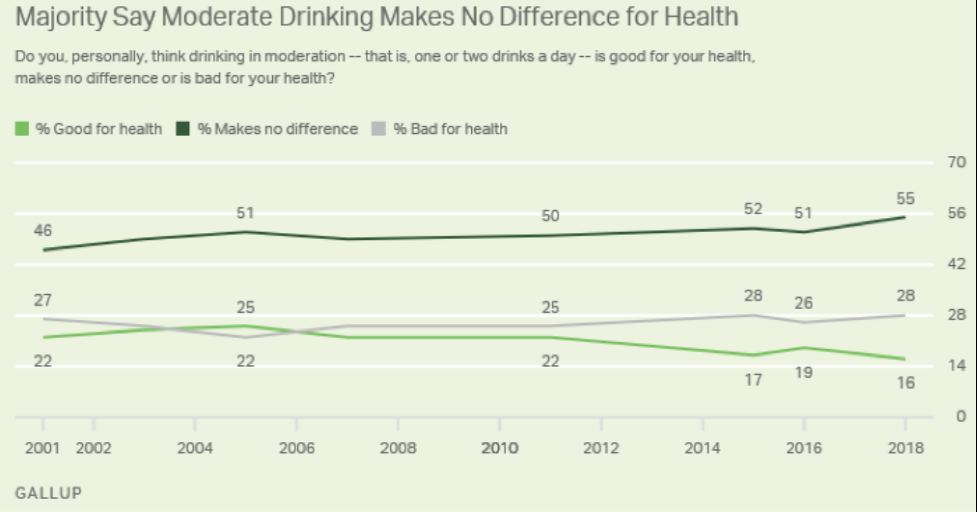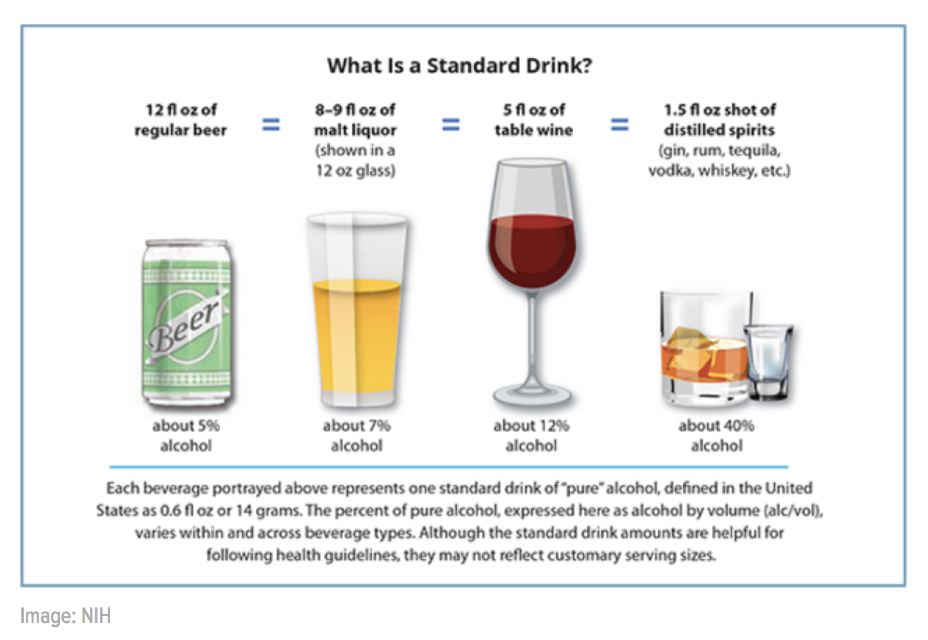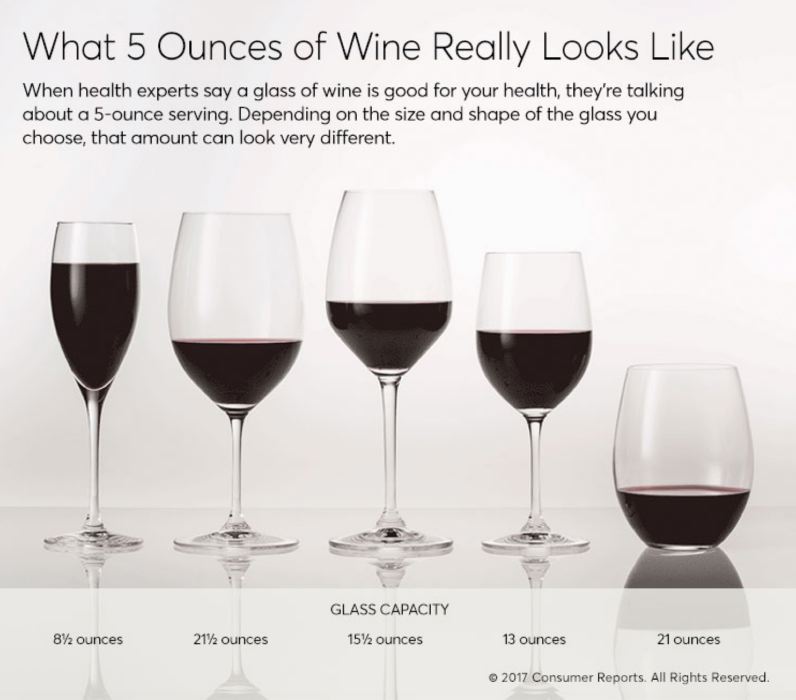The Continuing Debate Over the Health Benefits of Wine
The ongoing argument about the benefits of moderate consumption of wine and other beverage alcohol as part
of a healthy lifestyle continued in 2018. The country’s Puritan heritage has caused a conflicted attitude about
wine and has led us to seek justification for drinking wine beyond its gustatory and social pleasures.
The results of a myriad of observational research studies published in 2018 were often sensationalized by the
lay press and only served to confuse the public. A review of 64 of the most shared media articles pertaining to
50 academic articles that appeared in the peer-reviewed science journal PLOS One in May 2018 found that
health news stories often overstate the evidence from a new study, and 58 percent of media articles
inaccurately reported the question, results, intervention or population of the academic study, as well as
incorrectly attributing causal relationships. The chart below from that publication compares the strength of
causal inference in academic studies with the strength of causal language in media articles.

The public is thoroughly confused and I am exasperated. As a medical doctor, I read much of the medical
literature and research on the relationship between alcoholic beverages and health, yet I cannot arrive at a
clear vision of the relationship. Practically every published research study ends with the disclaimers such as,
“Further study is necessary,” “More research is needed to explain the results,” and “The results may be
explained by biases and confounding.” The word, “suggestive,” or the two words, “interpret cautiously” are
often employed.
Some of the global research on alcohol is “junk science,” particularly research funded by health agencies
looking for something to regulate, as pointed out by the informed critic, Terence Corcorian, writing in the
Financial Post in June 2018. He correctly noted, “Finding that people who consume certain foods or drinks also
develop heart disease or cancer is not an indicator that the food or drink causes those diseases.”
A Gallop poll published in 2018 asked consumers if they considered drinking in moderation (one or two drinks a
day) was good for their health. The results over a 17-year period indicate the public is still conflicted about the
possible health benefits of moderate drinking. More consumers now believe moderate drinking has no health
benefit and fewer trust that it is good for their health.
Much of the uncertainty surrounding the health benefits of moderate drinking stems from the fact that scientific
research to date has been performed either in vitro on lower life forms (rats, yeasts, worms) or in vivo with
cohort and case-control analyses. There have been no well-executed, randomized, double-blinded, intervention
trials controlled for all confounding variables. A comprehensive randomized study is impractical because it
requires documenting long-term behavior over decades and represents a real perceived risk of harmful effects.
A noted American researcher, Arthur L. Klatsky MD, has pointed out, “The major issue is residual confounding
variables by diet, smoking or other traits, problematic statistical modeling, and underestimation of drinking
amount through self-reporting which lowers the apparent threshold of risk. As a result, the issue of how well we
can infer causality from observational data remains a formidable challenge.”
Still, it is apparent to researchers that well-performed observational studies can establish a high
probability of causality in these data.” Valuable critiques of currently published scientific papers is available
to the public by members of the International Scientific Forum on Alcohol Research (ISFAR), a joint
undertaking by the Institute on Lifestyle and Health of the Boston University School of Medicine and Alcohol in
Moderation (AIM) organization of the United Kingdom. ISFAR consists of an international panel of invited
physicians and scientists who are specialists in their fields and committed to unbiased, balanced and well-researched
analyses regarding alcohol and health. All reviews and publications of ISFAR’s work are on a
volunteer basis and ISFAR has had no financial support from the beverage industry or related organizations for
the past 3 or 4 years.
ISFAR, through its open website at www.alcoholresearchforum.org, and AIM through its Alcohol in
Moderation Digest Online at www.aim-digest.com, study summaries, timely critiques and comments on
emerging scientific publications and policy statements related to alcohol and health. ISFAR and AIM provide an
opportunity for all to seek expert opinion on topics related to alcohol and health.
In 2018, I reviewed all the major scientific publications related to alcohol and health, many lay press
articles, and multiple ISFAR critiques, and tried to arrive at some well-established facts regarding the
health benefits of wine and other alcoholic beverages that reflect the current opinion of a majority of
the scientific community. In addition, some of the views offered below were derived from the research and
opinion of Arthur L. Klatsky MD, a highly respected researcher in the alcohol and health field. My intention in
presenting this scientific-based information is to dispel some of the growing and irresponsible negative press
about drinking in moderation as part of a healthy lifestyle.
1. Alcohol research is complicated by confounding. For example, non-drinkers may not drink because of
health problems and this can cause a misleading impression of cause and effect. Many research studies
now attempt to control for confounding variables.
2. A common criticism of studies that show health benefits for moderate alcohol consumption is that “sick
quitters” (those that gave up alcohol) can skew the apparent benefits of moderate drinking. Some newer
studies are designed to exclude sick quitters from abstainers.
3. The website of the National Institutes of Health (NIH) in the U.S. states that moderate consumption of
alcohol (one drink a day for women and two for men) may have beneficial effects on health, including
reducing the risk of heart disease stroke and diabetes. This is in line with the widely accepted
recommendation of one glass of red wine a day for women and up to two glasses of red wine daily for men,
assuming there are no medical contraindications (individual ideals may vary).
4. There is absolutely no added benefit to drinking more than moderate amounts of wine daily. Heavy drinking
or binge drinking is associated with negative health consequences.
5. Low to moderate alcohol consumption for adult or old people has been linked with potential health benefits
including decreased risk of coronary heart disease and mortality, protection against congestive heart failure,
decreased risk of ischemic stroke, and protection against type 2 diabetes, rheumatoid arthritis, cognitive
impairment, dementia and Parkinson’s disease. The exact physiological explanation behind these
associations is not fully understood.
6. Moderate alcohol consumption does not outweigh the possible heart-related benefits in young men
because of the increased risk of alcohol-related accidents. For young women, there is a low risk of
cardiovascular disease, so that the risk of moderate drinking exceeds the benefits.
If you wish further detailed information about the most significant 2018 research in the alcohol and health
field, read the subsequent sections of this issue.
7. The cardiovascular benefits of moderate alcohol consumption increase with age so that a 60-year-old
man who drinks one drink a day can expect that the protection afforded against heart disease is likely to
outweigh the potential harm. A 60-year-old woman is more likely to die from heart disease than breast
cancer (woman suffer just over half of all fatal heart attacks), so the benefits of light to moderate
consumption outweigh the risks, although women are often more afraid of breast cancer. In other words,
mature adults benefit potentially the most from light to moderate alcohol consumption, and the reduced risk
of cardiovascular disease and mortality clearly outweighs possible cancer or other disease risks, as
demonstrated by the J-shaped curve.
8. A safe level of alcohol during pregnancy has not been determined and many medical organizations
including the Centers for Disease Control (CDC) recommend women should avoid drinking completely
during pregnancy or pre-pregnancy if they are not using birth control and there is any chance they might be
pregnant.
9. For most cancers, there is a dose-response curve in that risk increases with the more alcohol that is
consumed on a regular basis. Epidemiological evidence is strong for an association of chronic heavy
alcohol consumption with cancers of the oral cavity, pharynx, larynx, esophagus and liver. There is a fairly
consistent association of heavier alcohol consumption with female breast cancer, but there is considerable
debate about the presence and level of a risk threshold. The data on many other cancer types is
inconclusive. Wine does not appear to be a healthier drink from the standpoint of cancer risk.
10.The health benefits from alcohol and in particular red wine are only obtainable through regular and
moderate consumption. Wine consumed with a meal may be healthier as drinking wine increases
cardioprotective effects, aids digestion (the pH of wine is close to that of stomach acid), decreases food-borne pathogens, and may help diabetics
metabolize sugars and starches.
11.Red wine is possibly healthier than other alcohol beverages because of its polyphenol content.
12.Your physician should always be consulted before altering your alcohol consumption habits. Medical
professionals do not advise abstainers to begin drinking for health reasons.
To understand “moderate drinking,” and the standard drink size referenced in this issue, a few definitions are in
order. In the U.S., a standard drink or unit contains 17.7 ml or 14 gm or 0.6 ounces of ethanol which is
equivalent to 12 ounces of about 5% alcohol by volume beer, 5 ounces of 12% alcohol by volume wine and a
shot (1.5 ounces) of 80-proof or 40% alcohol by volume distilled spirits or liquor. A full bottle of wine contains
750 ml or 25 ounces which is 5 to 7 standard drinks depending on the alcohol percentage. A bottle of 16%
alcohol wine will have about 1 more drink than a bottle of 13% alcohol, the point being that alcohol percentage
does make a difference when you are looking to drink in moderation. One would want to scale back the volume
of drinking when imbibing a wine with a higher alcohol percentage.
It is helpful to consider what a standard drink or 5 ounces of wine looks like depending on the type and size of
wine glass chosen:
As an informed physician, I am with the majority of health experts who are confident that wine in
moderation is good for you, especially for middle-age to older people. If nothing else, it provides
gustatory pleasure and relaxation. There is no optimal level of alcohol consumption. My prescription is
5 ounces of wine (one standard drink) for women and up to 10 ounces of wine (two standard drinks) for
men, preferably red and Pinot Noir, to be enjoyed most days and consumed with food. That said, wine
drinking may not be advisable for everyone, and one should consult with their doctor about the effects
of wine consumption on their health as well as lifestyle and diet advice, and choose a personalized
course. Those under 21 years of age should not consume alcohol.






